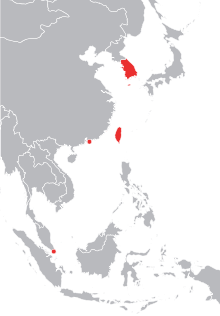 You will recall from the last sequel of the current discussion that the Asian Tiger Economies, after which I sought to discuss whether Tanzania could emulate, I discussed that these countries had recorded a rapid economic growth because of “[a]n emphasis on human capital accumulation through intensive investments in education, interacting with technology transfer that was obtained through a direct purchase, and educating large numbers of skilled engineers who would ‘absorb and adapt the most advanced technology.'”
You will recall from the last sequel of the current discussion that the Asian Tiger Economies, after which I sought to discuss whether Tanzania could emulate, I discussed that these countries had recorded a rapid economic growth because of “[a]n emphasis on human capital accumulation through intensive investments in education, interacting with technology transfer that was obtained through a direct purchase, and educating large numbers of skilled engineers who would ‘absorb and adapt the most advanced technology.'”
It was a natural question for me to ask why we could not simply copy what they did i.e invest in education, technology and emphasize on an improved savings rate. I naively put that we cannot do that because Tanzania is “broke.”
Furthermore, and as some readers discussed, it became a general truth that: “Investing is more than just taking risk; it involves a mindset that is prepared to anticipate further risk, plan accordingly, and put resources to use so as to minimize future risk. All that involves coming into contact with the same bureaucracy that re-enforces the same problems with economic development…” Therefore we “[must] [not only] be strategic about investment” but also look at sectors where “we have a competitive advantage in (mining for instance).” However, in all this the role of the government is not devoid but it must be adaptable to the passage of time and policy. (Comments from SL, Aidan and AK, irrespectively)
In this post, I do not wish to discuss the challenges of investing in Tanzania or more politically inclined challenges. I, however, wish to discuss why investment makes sense.
Like human beings, countries that are “broke” need an economic boost by, I shall loosely call it, borrowing from other countries. Borrowing may be in several forms such as grant, aid and loan. The money obtained through borrowing can then be wisely invested in key sectors in a way that leads to profit which would not only be used to repay any outstanding debts but to invest in other projects with the end goal of becoming self-sufficient — in capital terms. Another form for capital raising is through taxing citizens and businesses. Depending on the level of financial endowment of the people and businesses and the consumption (e.g. consumption on public goods), taxing may not suffice to provide enough funds from which a government may accumulate its intended capital. Therefore, the government must, in addition to its citizens and firms, involve itself in investment in businesses that can generate profit for further capital accumulation. By capital, I mean money capital.
To this point I have tried to hightlight ways through which a government can raise its income which forms part of the national income. I have also tried to assert that in a “broke” country, the government must take an active role in shaping the country’s economy.
The money capital of a country together with its consumption and investment and that of its citizens and firms is what is called the national income. Therefore, the national income, as I shall refer to in the rest of the discussion, is a function of consumption and investment — it is the sum of consumption and investment. I must also assert that a basic idea of economic growth is an increase in the national income. Now that the national income is defined as the sum of consumption and investment, it is our interest to see how the national income can be effectively increased. And to this I shall now turn.
At any point the national income can be increased by an increase in either or both. The theory of the multiplier is a theory that tries to make estimates on the trade-offs of spending either in investment or consumption. In the present discussion, the multiplier will define the marginal effect of investment or consumption on the national income. In other words, we want to measure the quantity of national income we gain by investing or consuming.
An increment in the rate of investment today leads to induced additional positive or negative investment and an increment in consumption as a result of an additional national income generated by today’s increment in investment. Similarly, an increment in the rate of consumption today leads to induced additional consumption due to an increase in national income resulting from an increase in investment generated by today’s increase in consumption. Thus the net effect of an increment in consumption or investment on the national income is the same, i.e the consumption and investment multipliers are equal. Hence, it does not matter whether the government spends on consumption or investment, the net effect on national income is the same.
So what does this mean? It means, the government has no advantage over either way of expenditure.
However, here is the trick. As we are faced with a “broke” country we could have the government to minimally but smartly either consume or invest. In the short term the government should spend on things that will actually have the public — people and firms — spend more of their money. With an increased spending from the public, the government will compensate for the spent money through the collection of taxes. It is possible in theory that the government will obtain every shilling spent this way. The national income will increase as a result of an increase in public’s aggregate spending.
In the long run, the government must aim for long term projects whose returns would take several years to pay. Examples are construction works and manufacturing industries.
The situation we have just considered assumes that the country operates in a closed system. In reality, countries interact with other countries through trade. In this case spending can be split into two categories: (1) internal spending for domestic goods, and (2) external spending such as payment for imports. For every shilling spent abroad, a fraction of it returns to the country; the national income is the sum of internal spending and the rate of external receipts. External receipts can be considered as payment received from exports of goods.
Assuming that both internal and external spending are a function of national income, an increment in the rate of internal spending leads to an equal increase in the national income. Of this increment in national income only a fraction of it which equals the product of this rate and the marginal propensity to spend internally is spent internally which leads to an even further increase in national income. The amount of national income spent externally increases as well due to the increase in aggregate income. Of the amount spent externally, a fraction of it is spent back as receipts from exports and hence increases the national income. It is the product of the marginal propensity to spend externally and the rate of external receipts. Therefore, an increment in the rate of internal spending triggers a series of induced and non-induced spending whose sum equals the total increase in the national (aggregate) income.
Suppose that instead of an increment in the rate of internal spending, we increment the rate of total spending which is the sum of internal and external spending. This will trigger an increment in internal spending and an inward flow of income from external spending. Thus, the change in internal income will be the sum of this multiplied by the increment in total spending. This will further lead to an additional increment in internal spending and inflow-income in a series, a power series, whose sum will equal the total increase in the national income.
It follows that at any point we are essentially faced with two decisions, either to increment internal spending or increment total spending because we would like to maintain a net inflow of income which will ultimately increase our national income. It also follows that a country must struggle to maintain that it either spends more internally than it spends on imports or exports more than it imports. Spending more on exports is a better strategy because it will bring a net inflow of income. (You will remember that the national income is the sum of internal spending and the rate of external receipts.)
By analyzing the effect of internal or total spending on external spending, by a similar methodology discussed in the preceding paragraphs, we will arrive at a point where we would be able to choose a fiscal policy. This policy will take one of the following forms: (1) equalize changes in internal spending and changes in rate of external receipts, (2) maintain a constant budget deficit, (3) maintain a constant budget surplus, or (4) maintain a balanced budget.
To this point, I shall welcome us to discuss whether we can unlock our economy.
Previous articles:



Well economically analyzed. That i must say. Economics always sounds so easy and everything can be done at a go. What the article lacks however is the social part and reasons. 90% of the ways highlighted here have been practiced in Tanzania. For instance, tax increment. we are a step away to demonstrate and cause fracas due to the high rise of taxes. The highlighted economic theories can unlock the economy without a doubt. what they lack however is the CORRUPTION part. Non of them talk about the ways of tackling the problem. This is the massive problem Tanzania and Africa face. The government has tried to acquire funds from the public by selling the unwanted properties. corruption arises and they are sold at a relatively cheaper price and the money is never seen in the governments books. This and the many has definitely contributed to locking of our economy. The government is loosing a lot of money easily and putting so much effort to get it back. We need to make our own (Africa) economic theories which includes corruption to unlock. Africa is a completely different market. Each day that passes is a dream by itself. Kibera and the likes are swimming in dreams. Hope arises when a beam of sunlight shines in the African eyes.
This post is a great read! I especially appreciated the incorporation of responses to previous posts on this subject; this act of incorporating public opinion and thinking collectively is a huge advantage of new media technologies some of us have access to today.
On the matter of thinking collectively, one question I kept asking myself throughout this post is: Can we be sure that there is *one* body in the government that will always comply consistently with any fiscal policy that is introduced?
Another way to ask this would be: Is this “government” made up of one interest or many?
If the answer is that it is made up of one interest, then it would help to continue thinking along the lines of neoclassical economic theory.
But if the answer is that the government is made up of many interests (and the author does mention that “countries interact with other countries”, and I would extend this to say that people interact with other people as well), then perhaps a more contemporary, political economy approach is more worthy for considering a revamped fiscal policy.
This would involve assuming that power talks within any flows of capital. And here I refer to capital not in terms of money alone, but in terms of resources, time, effort and attention. Flows favor strong and cohesive social relations, whereas flows are weak where cohesion is weak (interesting paper on Social Capital here).
This is apparent in Tanzania: Some parts of the country recieve less investment than others. Instead of assuming that the country as a whole needs increased investment (or more spending on exports for that matter), can we assume that some parts of the country need more investment than others and begin there?
Another view from Mzumbe university professor on the sanctity of LAND in Tanzania’s economic development: http://thecitizen.co.tz/business/-/20693-the-sanctity-of-land-for-economic-development-in-tanzania
How do we balance the high demand for land with the changes to internal/external investments suggested by this immediete blog post?